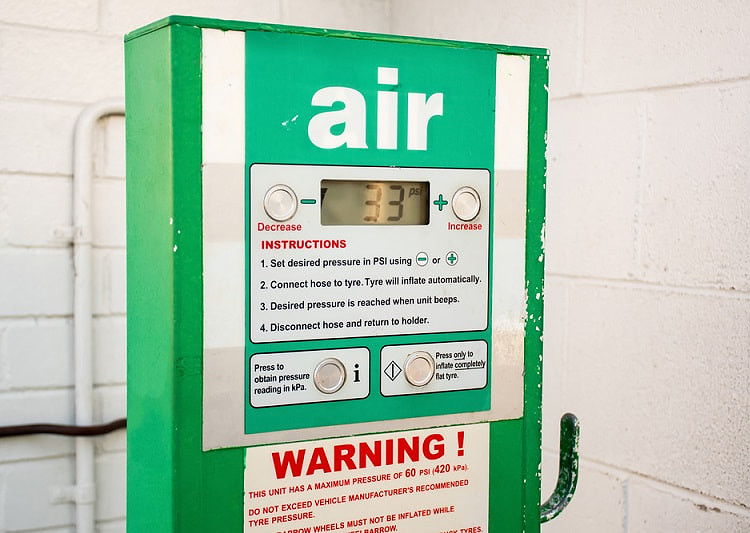Gas station air pumps are convenient resources for motorists.
If you do not have a way to put air in your tires at home, you can just pull up to one of these pumps, fill up your tires for a low fee, and drive away on happy tires.
Are your tires filled with the proper amount of air?
You are about to learn if you can trust the psi (pounds per square inch) level that your gas station air pump claims to have filled in your tires.
But first, let’s cover why it is important to have the correct psi in your tires.
Table of Contents
Importance of Correct Tire Pressure
If your tires are not visibly flat, you may think your tires are perfectly fine. Many people do not think about their tires being underinflated, much less overinflated.
However, it is important to know the proper amount of air your tires need.
How Much Air to Put in Your Tires?
Your vehicle will have a recommended psi for your tires. You should be able to find this information on the inside of your door on the driver’s side.
There should be a tag on the frame of your door.
If you are unable to locate the tag, you can also find this information in your owner’s manual for your vehicle.
Most commonly, vehicle tires will be recommended to be filled between 30-35 psi.
If your tire pressure is not in the correct range, you could be negatively affecting your vehicle’s performance, and could also be putting yourself in danger.
This applies to both underinflated and overinflated tires.
Effects from Overinflated Tires
If you have too much air in your tires, this will cause your tires to expand and become tight and firm.
When your tires are more firm, they will provide less cushion when you are driving on the road. You are likely to experience a more uncomfortable ride as you drive over bumps.
These overinflated tires will also increase your risk of having a flat tire. As your tires are expanded and become tight, they can become more sensitive to objects on the road.
It will be easier for these objects to penetrate your tires.
When your tires are providing less cushion, they will not form on the road as well. You will have less tire surface touching the road.
With less tire material touching the road, your vehicle will naturally have less traction. This can be very dangerous for you and any passengers.
Since only the center of your tires will be touching the road, you will also experience a considerable amount of wear and tear in those areas, which will lead to you having to replace your tires sooner.
Effects from Underinflated Tires
When your tires are underinflated, they tend to flex a bit more. This flexing can cause several negative impacts on your tires.
Your vehicle’s stability and traction will be greatly affected. When your tires flex, they are not holding up and supporting your vehicle properly.
Your tires will have more surface area touching the road, which will add more friction to your vehicle. This will increase the wear on your tires, but can also lead to lower fuel mileage, difficulty steering, and your brakes needing more distance to stop your vehicle.
Heat will also be produced from your tires flexing, and this may cause a dangerous blowout while you are driving.
As you can see, it is very important to have the correct amount of pressure in your tires.
Now let’s find out if your gas station air pump can accomplish this.
How Accurate Are Gas Station Air Pumps?
Many gas station air pumps allow you to select your preferred tire pressure before you start filling your tires.
When your tire reaches the specified pressure, the air pump should start beeping to let you know that your tire is filled.
You may think that this is a convenient feature, but gas station air pumps have become seemingly notorious for being inaccurate.
Many people report that their tire pressure reading from the gas station air pump does not match the reading on their tire pressure gauge.
That’s right- the air pump that you just inserted money into may not be accurate after all.
Earlier we covered all the negative effects of incorrect tire pressure. Even if the air pump at the gas station happened to be accurate, would you want to risk it?
How would you know that your pump was accurate?
You wouldn’t- unless you owned a tire gauge.

Many motorists carry a tire gauge somewhere in their vehicle. These gauges are small, simple, and usually very cheap. You can find plenty of gauges for just a few dollars.
When we consider the cost and simplicity of these devices, there’s no reason that you shouldn’t own and use one yourself.
After filling your tires at a gas station air pump, you can use a tire gauge to double-check the pressure in your tires. You can add or release air accordingly.
Afterward, you can throw it into your vehicle’s glove compartment and be on your way- it’s that simple!
If you think your tires are dangerously low, it may be wise to still consider using a gas station air pump for the time being, but you need to follow up with your tire gauge later on.
There are a few types of tire gauges you can pick.
Types of Tire Gauges
There are three types of gauges for your tires:
- Stick
- Digital
- Dial
1/ Stick Gauges
- RUGGED DESIGN: The stainless steel components prevent rust and corrosion while the precision-crafted nozzle seamlessly seals onto the valve stems for highly accurate readings (±2% span). We also...
- 3 UNITS AVAILABLE: Measures from 10-75PSI, 70-550kPa, and 0.7-5.5Bar. The 4-side indicator bar is made of ABS materials and provides clear readings. Please note that exceeding the gauge’s maximum...
Last update on 2025-12-19 at 21:38 / Affiliate links / Images from Amazon Product Advertising API
These types of gauges have a narrow, cylindrical shape while still maintaining a small profile.
Inside these gauges, there is a stick that has markings on it to show you how much pressure is in your tire.
After putting the gauge on your tire, the stick will slide out according to how much pressure it reads. Read the marking on the stick to find out how much pressure you have.
2/ Digital Gauges
- EXPERT-GRADE CALIBRATION: Each AstroAI Tire Pressure Gauge is calibrated with professional-grade tools, ensuring quick and accurate measurement results within plus-minus 1PSI. Stay prepared for any...
- SEAMLESS TESTING IN DIM AREAS: The AstroAI Digital Tire Pressure Gauge is equipped with an illuminated nozzle and backlit LCD screen. Use the illuminated nozzle to find the car valve stem in dim...
Last update on 2025-12-19 at 21:38 / Affiliate links / Images from Amazon Product Advertising API
These gauges are pretty straightforward and are also considered to be the most accurate.
There is a screen on the gauge that will show you the pressure reading.
Just put the gauge on your tire, read the screen, and move to the next tire.
Some screens light up, so you can even measure your pressure easily when it’s dark.
3/ Dial Gauges
- HIGH PERFORMANCE LOW MAINTENANCE - Your car is one of your partners in life. Making sure it performs at its best takes tender loving care, which means essentially checking tire pressure regularly. But...
- SAFETY FIRST - Driving your family, friends or simply carpooling is a big responsibility. Protecting your passengers means keeping your car in top condition. Properly inflated tires are safer and less...
Last update on 2025-12-19 at 21:38 / Affiliate links / Images from Amazon Product Advertising API
When using these gauges, a needle will move in a circular motion similar to a clock.
Put your gauge on your tire and see which pressure reading the needle is pointing to.
Some of these gauges also include a hose attached to them. The end of the hose connects to the valve stem on your tire, similar to the other gauges.
Conclusion
Although gas station air pumps are highly convenient, it is probably not wise to fully trust their accuracy.
You can still use them to fill your tires with air, but you should consider dishing out a few dollars and purchasing a tire gauge so you have another method of checking your tire pressure.
Be sure to check your tire pressure at least once and month, and make this a part of your regular vehicle maintenance.
For more information on using a gauge to check your tires, check out these steps recommended by Bridgestone.

I created this site to help people – to help you – with your boat problems. Instead of helping one person at a time, I want this website to be the “one-stop-shop” for everyone’s boating concerns. Read more.




